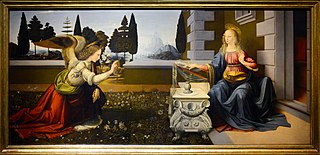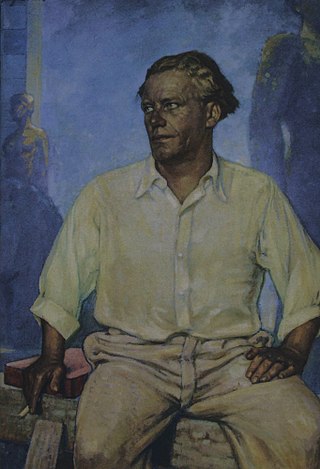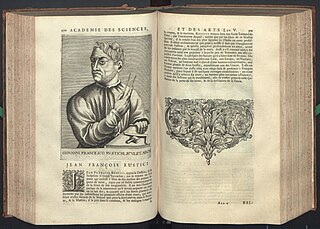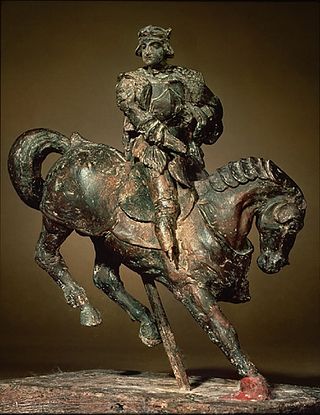
Flora is a wax sculpture of Roman goddess Flora by English sculptor Richard Cockle Lucas, currently located in the Bode Museum in Berlin. [1]

Flora is a wax sculpture of Roman goddess Flora by English sculptor Richard Cockle Lucas, currently located in the Bode Museum in Berlin. [1]
Wilhelm von Bode, the general manager of the Prussian Art Collections for the Berlin Museum, spotted the bust in a London gallery and purchased it for a few pounds for the Kaiser Friedrich Museum in 1909. Bode was convinced that the bust was by Leonardo da Vinci and the Berlin Museum authorities, and the German public, were delighted to have "snatched a great art treasure from under the very noses" of the British art world. [2]
In 1910, it was revealed that the work may have actually been created by the English sculptor, Richard Cockle Lucas. [3] Shortly after the purchase, The Times ran an article claiming that the bust was the work of Lucas, having been commissioned to produce it from a painting. Lucas's son, Albert, then came forward and swore under oath that the story was correct and that he had helped his father to make it. Albert was able to explain how the layers of wax had been built up from old candle ends; he also described how his father would stuff various debris, including newspapers, inside the bust. When the Berlin museum staff removed the base they found the debris, just as Albert had described it, including a letter dated in the 1840s. [2]
Despite this evidence, Bode continued to claim that his original attribution was correct. To support this, he displayed the Flora bust among a selection of Lucas's lesser work – this exhibition rather backfired, however, as it showed that Lucas had been regularly making wax sculptures inspired by the great works of previous times. [2] In April 2021, the bust was dated using carbon-14, which confirmed that it was sculpted in the 19th century. [4] [5] The bust remains on display in what is now the Bode Museum labeled "England", "19th Century" with a question mark. [6]

The Victoria and Albert Museum in London is the world's largest museum of applied arts, decorative arts and design, housing a permanent collection of over 2.27 million objects. It was founded in 1852 and named after Queen Victoria and Prince Albert.

Andrea del Verrocchio was an Italian sculptor, painter and goldsmith who was a master of an important workshop in Florence.

The Annunciation is a painting widely attributed to the Italian Renaissance artist Leonardo da Vinci, dated to c. 1472–1476. Leonardo's earliest extant major work, it was completed in Florence while he was an apprentice in the studio of Andrea del Verrocchio. The painting was made using oil and tempera on a large poplar panel and depicts the Annunciation, a popular biblical subject in 15th-century Florence. Since 1867 it has been housed in the Uffizi in Florence, the city where it was created. Though the work has been criticized for inaccuracies in its composition, it is among the best-known portrayals of the Annunciation in Christian art.

Josef Thorak was an Austrian-German sculptor. He became known for oversize monumental sculptures, particularly of male figures, and was one of the most prominent sculptors of the Third Reich.

The Portrait of a Musician is an unfinished painting widely attributed to the Italian Renaissance artist Leonardo da Vinci, dated to c. 1483–1487. Produced while Leonardo was in Milan, the work is painted in oils, and perhaps tempera, on a small panel of walnut wood. It is his only known male portrait painting, and the identity of its sitter has been closely debated among scholars.

A wax sculpture is a depiction made using a waxy substance. Often these are effigies, usually of a notable individual, but there are also death masks and scenes with many figures, mostly in relief.

Wilhelm von Bode was a German art historian and museum curator. Born Arnold Wilhelm Bode in Calvörde, and known as Wilhelm Bode for most of his career, he was ennobled in 1913, and thereafter adopted the aristocratic "von". He was the creator and first curator of the Kaiser Friedrich Museum, now called the Bode Museum in his honor, in 1904.
Events from the year 1909 in art.

The Bode Museum, formerly called the Kaiser-Friedrich-Museum, is a listed building on the Museum Island in the historic centre of Berlin. It was built from 1898 to 1904 by order of German Emperor William II according to plans by Ernst von Ihne in Baroque Revival style. The building's front square featured a memorial to German Emperor Frederick III, which was destroyed by the East German authorities. Currently, the Bode-Museum is home to the Skulpturensammlung, the Museum für Byzantinische Kunst and the Münzkabinett. As part of the Museum Island complex, the Bode-Museum was inscribed on the UNESCO World Heritage List in 1999 because of its outstanding architecture and testimony to the development of museums as a cultural phenomenon in the late 19th and early 20th centuries.

Giovan Francesco Rustici, or Giovanni Francesco Rustici, (1475–1554) was an Italian Renaissance painter and sculptor. He was born into a noble family of Florence, with an independent income. Rustici profited from study of the Medici sculpture in the garden at San Marco, and according to Giorgio Vasari, Lorenzo de' Medici placed him in the studio of Verrocchio, and that after Verrocchio's departure for Venice, he placed himself with Leonardo da Vinci, who had also trained in Verocchio's workshop. He shared lodgings with Leonardo while he was working on the bronze figures for the Florence Baptistry, for which he was ill paid and resolved, according to Vasari, not to work again on a public commission. Moreover, an echo of Leonardo's inspiration is unmistakable in the much-discussed and much-reviled wax bust of "Flora" in Berlin, ascribed to a circle of Leonardo and most probably to Rustici. At this time, Pomponius Gauricus, in De sculptura (1504), named him one of the principal sculptors of Tuscany, the peer of Benedetto da Maiano, Andrea Sansovino and Michelangelo. It may have been made in France, perhaps in the circle of Rustici, who entered Francis I's service in 1528.

Leonardo's Horse is a project for a bronze sculpture that was commissioned from Leonardo da Vinci in 1482 by the Duke of Milan Ludovico il Moro, but never completed. It was intended to be the largest equestrian statue in the world, a monument to the duke's father Francesco Sforza. Leonardo did extensive preparatory work for it but produced only a large clay model, which was later destroyed.

Richard Cockle Lucas was a British sculptor and photographer.

La Scapigliata is an unfinished painting generally attributed to the Italian High Renaissance artist Leonardo da Vinci, and dated c. 1506–1508. Painted in oil, umber, and white lead pigments on a small poplar wood panel, its attribution remains controversial, with several experts attributing the work to a pupil of Leonardo. The painting has been admired for its captivating beauty, mysterious demeanor, and mastery of sfumato.

Horse and Rider is a beeswax sculpture depicting a rider on a horse. The history of the sculpture is unknown before the 20th century. The work has been attributed to Leonardo da Vinci by the Italian art historian Carlo Pedretti, though most historians have ignored or denied the attribution. A number of casts have been made, using a mold taken from the wax original.

The Rearing Horse and Mounted Warrior or Budapest horse is a bronze sculpture attributed to Leonardo da Vinci. Depicting Francis I of France on a destrier horse, it is estimated to have been cast from a clay or wax model in the first half of the 16th century. The sculpture is in the permanent exhibit of the Budapest Museum of Fine Arts.

Paul George Konody was a Hungarian-born, London-based art critic and historian, who wrote for several London newspapers, as well as writing numerous books and articles on noted artists and collections, with a focus on the Renaissance. A recognized expert on the art of the Renaissance, he was lauded for his evaluation of claims of authenticity for works from that period, correctly debunking Wilhelm von Bode's assertion that a bust of Flora was sculpted by Leonardo da Vinci. During World War I, Konody became interested in the representation of war in the arts, and directed an effort to commemorate Canadian participation in that war.

Vertumnus and Pomona is a painting by Francesco Melzi dated to c. 1518–1522. It depicts the Roman god of the seasons Vertumnus in the guise of an old woman attempting to woo the lady Pomona. It is in the collection of the Gemäldegalerie of the Berlin State Museums.
Luke Syson is an English museum curator and art historian. Since 2019, he has been the director of the Fitzwilliam Museum at the University of Cambridge, prior to which he held positions at the British Museum (1991–2002), the Victoria and Albert Museum (2002–2003), the National Gallery (2003–2012) and the Metropolitan Museum of Art (2015–2019). In 2011 he curated the acclaimed Leonardo da Vinci exhibition at the National Gallery: Leonardo da Vinci: Painter at the Court of Milan, which included his pivotal role in the controversial authentication by the National Gallery of da Vinci's Salvator Mundi.

Italian Renaissance sculpture was an important part of the art of the Italian Renaissance, in the early stages arguably representing the leading edge. The example of Ancient Roman sculpture hung very heavily over it, both in terms of style and the uses to which sculpture was put. In complete contrast to painting, there were many surviving Roman sculptures around Italy, above all in Rome, and new ones were being excavated all the time, and keenly collected. Apart from a handful of major figures, especially Michelangelo and Donatello, it is today less well-known than Italian Renaissance painting, but this was not the case at the time.